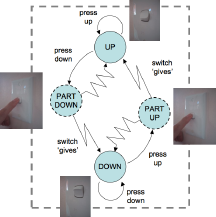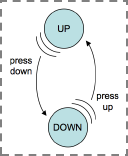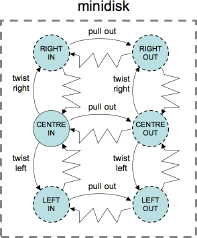References
- Benford, S., H.Schnadelbach, B. Koleva, B. Gaver, A. Schmidt, A. Boucher, A. Steed, R. Anastasi, C.Greenhalgh, T. Rodden and H. Gellersen, “Sensible, Sensable and Desirable: A Framework for Designing Physical Interfaces,” Technical Report Equator-03-003, Equator, (2003) http://www.equator.ac.uk/.
- Buxton, W., A Three-State Model of Graphical Input, in: Human–Computer Interaction – INTERACT
’90. Amsterdam: Elsevier Science Publishers B.V, (North-Holland), (1990), 449–456.
- Dix, A., “Formal Methods for Interactive Systems,” Academic Press, 1991
http://www.hiraeth.com/books/formal/.
- Dix, A. and G. Abowd, Model ling status and event behaviour of interactive systems. Software Engineering Journal, 11:6 (1996), 334–346 http://www.hcibook.com/alan/papers/SEJ96-s+e/.
- Dix, A., Getting Physical. keynote at: OZCHI 2003, Brisbane, Australia, 26-28 Nov 2003 http://www.hcibook.com/alan/talks/ozchi2003-keynote/.
- Dix, A., J. Finlay, G. Abowd and R. Beale, “Human-Computer Interaction. Third Edition,” Prentice Hall, (2004) http://www.hcibook.com/e3/.
- Gaver, W., Technology affordances. in: Proceedings of CHI ’91. ACM Press, (1991),79–84.
- Ghazali, M. and A. Dix, Aladdin’s lamp: understanding new from old. In 1st UK-UbiNet Workshop, 25-26th September 2003, Imperial College London (2003) http://www.hcibook.com/alan/papers/ubinet-2003/.
- Ghazali, M. and A. Dix, Visceral Interaction. in: Proceedings of the 10th British HCI conference, Vol 2, September 5-9, Edinburgh. (2005), 68–72 http://www.hcibook.com/alan/papers/visceral-2005/.
- Gibson, J., “The Ecological Approach to Visual Perception,” Houghton Mifflin Company, USA, 1986.
- Hartson, H., Cognitive, physical, sensory, and functional affordances in interaction design. Behaviour & Information Technology 22:5 (2003), 315–338.
- Nielsen, J., and R. Mack, “Usability Inspection Methods,” John Wiley & Sons, New York, 1994.
- Norman, D., Affordance, conventions, and design. Interactions 6:3 (1999), 38–43
- Pfaff, G., and P. Hagen, (Eds.). “Seeheim Workshop on User Interface Management Systems,” Springer- Verlag, Berlin, 1985.
- Shneiderman, B., Direct manipulation: a step beyond programming languages. IEEE Computer 16:8 (1983), 57–69.
- Wensveen, S., J. Dja jadiningrat and C. Overbeeke, Interaction Frogger: A Design Framework to Couple Action and Function. in: Proceedings of the DIS’04, ACM Press, (2004) 177–184
- UIMS The UIMS tool developers workshop: A metamodel for the runtime architecture of an interactive system. SIGCHI Bulletin, 24:1 (1992), 32–37,
|
 |

FIGURE 1.

FIGURE 2.
 
FIGURE 3.

FIGURE 4.

FIGURE 5.

FIGURE 6 (i).

FIGURE 6 (ii).

FIGURE 7 (i).

FIGURE 7 (ii).

FIGURE 8.
 
FIGURE 9.

FIGURE 10.
|













